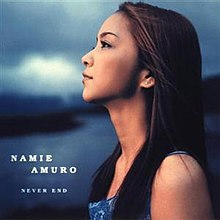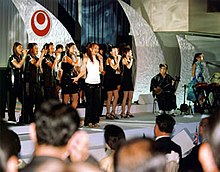
Namie Amuro is a retired Japanese singer. She rose to prominence as a teen idol, and transitioned into a leading pop artist due to her versatility across music styles and visual presentation. Due to her career reinventions and longevity, she is known as an icon across Japan and Asia. She has been referred to as the "Queen of Japanese Pop", and her influence domestically has drawn equivalent comparisons to artists such as Janet Jackson and Madonna in Western pop culture.

Love Enhanced Single Collection is the second greatest hits album by Japanese singer Namie Amuro. It was released on March 13, 2002, through Avex Trax. This was Amuro's first greatest hits album in about four years, since 181920. It was also her first greatest hits album since her return to the music scene. Although the album is labeled as a "singles collection," nearly all of the songs on the album have been re-recorded, re-mixed, or re-arranged, all of which remain exclusive to this album's release. In addition, only "Lovin' It" was recorded as a single take. The album also contains the last of the work she created with her longtime creative partner Tetsuya Komuro.

Break the Rules is the fifth studio album by Japanese recording artist Namie Amuro, released on December 20, 2000, through Avex Trax. It was released only 11 months after her previous album Genius 2000 (2000), and was her final album to date with her long-time producer Tetsuya Komuro, the album generally receive positive reviews by the critics, it was the shortlisted the Asia Association Music Prize Award.

Genius 2000 is the fourth studio album by Japanese recording artist Namie Amuro, released on January 26, 2000, through Avex Trax. The album was released three years after her last album, Concentration 20 (1997), and was produced by Tetsuya Komuro and Dallas Austin, marking her first collaboration with an American producer, the album spawned four singles: "I Have Never Seen", "Respect the Power of Love", "Something 'Bout the Kiss" and "Love 2000".

Concentration 20 is the third studio album by Japanese singer Namie Amuro. It was released on July 24, 1997, by Avex Trax. The album's musical style is a fusion of genres including pop, dance, rock, reggae and ska. Unlike Amuro's previous effort, Sweet 19 Blues (1996), which primarily had lyrics written by Tetsuya Komuro, Concentration 20's lyrics were mostly written by Marc Panther. Komuro did, however, compose and arrange most of the album's songs and wrote the lyrics to three of them. It was Amuro's second solo album since splitting up with Super Monkey's.

Sweet 19 Blues is the second studio album by Japanese singer Namie Amuro. It was released through Avex Trax on July 22, 1996. It is Amuro's first release with the label since leaving Toshiba-EMI, as well as her first album free of material associated with her previous band, Super Monkey's. Sweet 19 Blues was executive produced by Tetsuya Komuro and features a diverse group of collaborators, including Cozy Kubo, Akio Togashi, Takahiro Maeda, M.c.A.T, and Randy Waldman.

"Want Me, Want Me" is the 29th single by Japanese recording artist Namie Amuro. It was released by Avex Trax on April 6, 2005, and was the last retailed single to precede her seventh studio album, Queen of Hip-Pop (2005). "Want Me, Want Me" was initially supposed to be released as an album track of Queen of Hip-Pop or a coupling song, but Amuro thought it was so good she made it a single despite the opposition of her staff. The song's lyrics were written by Michico, while its music was composed by Sugi-V. Musically, "Want Me, Want Me" is an upbeat reggae-style tune with an addictive loop that incorporates Japanese elements like the koto that plays during the intro. Atypical for Amuro, the song contains sexually aggressive lyrics and namechecks the condom brand Trojan in the chorus.

"How to Be a Girl" is the tenth single by Japanese recording artist Namie Amuro. It was released on May 21, 1997, through Avex Trax. It was used as the Bristol-Myers Sea Breeze commercial song, which was used for four commercials. The style of the song is similar to that of her single "A Walk in the Park," which has an evident electronic sound in the vein of her producer Tetsuya Komuro's group globe. Lyrics were even written by Marc Panther, who is another member of the group. This was the final single from her third studio album Concentration 20 (1997), which was released two months later. The single is a follow-up to "Can You Celebrate?", which became her biggest hit.

181920 is debut greatest hits album by Japanese singer Namie Amuro. Avex Trax released it in Japan on January 28, 1998, and it was later available in a variety of formats throughout Asia. The album contains Amuro's single releases from her debut studio album Dance Tracks Vol. 1 (1995) to her third album Concentration 20 (1997), as well as three tracks from her time with Toshiba-EMI. The album also included a new song called "Dreaming I Was Dreaming," which served as the only single from the album.

"Say the Word" is the 18th single by Japanese recording artist Namie Amuro, and her 7th vinyl record. The CD single was released on August 8, 2001, by Avex Trax. The vinyl edition was released on September 12, 2001, by Rhythm Republic. This is Amuro's first single since severing ties with her former long-time producer Tetsuya Komuro. The song is not found on any of her studio records, but was later placed on her second best album Love Enhanced Single Collection, which was released five months later. It was produced by Swedish producers Ronald Malmberg and Thomas Johansson who are best known for their work with Swedish pop group A-Teens.

"Can You Celebrate?" is the ninth single by Japanese recording artist Namie Amuro. Serving as the second single from her third studio album Concentration 20, it was released on February 19, 1997, by Avex Trax. Its lyrics and composition was handled solely by Tetsuya Komuro. Musically, "Can You Celebrate?" is a power ballad that incorporates gospel and classical music. Lyrically, the song express a longing for a deep and lasting love, asking if the listener can celebrate and kiss the singer.

"A Walk in the Park" is the eighth single by Japanese recording artist Namie Amuro from her third studio album Concentration 20 (1997). The song was released as the album's lead single on November 27, 1996, by Avex Trax. It was written, composed and produced by Tetsuya Komuro. The song is an electronic rock track, which features instrumentation from guitars, synthesizers, organs, keyboards and drums. Lyrically, it explores themes of loneliness, longing, and the desire for connection.

"Sweet 19 Blues" is the seventh single by Japanese recording artist Namie Amuro. It was composed, written and arranged by Tetsuya Komuro for her debut album of the same name. A month after its release, her label Avex Trax released the song as a recut single due to overwhelming demand. The song's subject and the album in general was about the melancholic passing of another sweet year of youth, which is a particularly Japanese obsession.

"You're My Sunshine" is the sixth single by Japanese singer Namie Amuro. It was released on June 5, 1996, by Avex Trax and was produced by Tetsuya Komuro. The song was the image song for the Bristol-Myers Squibb "Sea Breeze '96" commercial in which she appeared. The version used in the initial commercial had a different tempo and tune from the CD package version. The following year, 1997, she was used for the second consecutive year in a "Sea Breeze" commercial, this time using her hit song "How to Be a Girl".

"Chase the Chance" is the fourth single by Japanese singer Namie Amuro from her second studio album, Sweet 19 Blues (1996). It was released as the album's second single on December 4, 1995, through Avex Trax.

"I Have Never Seen" is the twelfth single by Japanese singer Namie Amuro. It was released by Avex Trax on December 23, 1998, as the lead single to her fourth studio album Genius 2000 (2000). The song was written and composed solely by Tetsuya Komuro. It was the first single released after Amuro's return from her yearlong maternity leave, and was released approximately one week before her well-publicized official comeback at the 49th NHK Kohaku Uta Gassen. Musically, the song is a melancholic power ballad.

"Respect the Power of Love" is the 13th single from Japanese recording artist Namie Amuro. The song was released on March 17, 1999, by Avex Trax. It was used as the KOSÉ Cosmetics' VISÉE commercial song and also the Asahi Drink "niceOne" commercial song. The album cover was also taken at the location where the music video was filmed. The music video was shot at Coyote Dry Lake, California, just like Madonna’s “Frozen” one year before.

"60s 70s 80s" is a triple A-side single by Japanese singer Namie Amuro from her third greatest hits album, Best Fiction (2008). It was released on March 12, 2008, through Avex Trax and consists of the songs "New Look," "Rock Steady" and "What a Feeling," each sampling from a specific decade in music, hence the title. "New Look" represents the 1960's and features a sample from The Supremes' "Baby Love." "Rock Steady" represents the 1970's and features a sample from Aretha Franklin's song "Rock Steady." The last song, "What a Feeling" represents the 1980's and features samples from Irene Cara's "Flashdance... What a Feeling," which was the theme for the 1983 film Flashdance.

Best Fiction is the third greatest hits album by Japanese singer Namie Amuro. It was released on July 30, 2008, by Avex Trax and features seventeen singles released between 2002-2008, which included five new songs, three of which were released as a triple A-side single called "60s 70s 80s." Furthermore, the album tracks "Do Me More" and "Sexy Girl" were released as digital singles.

Finally is the seventh greatest hits album by Japanese singer Namie Amuro. It was released in a variety of formats by her label Dimension Point on November 8, 2017, and was later distributed to other markets in Asia. It is the singer's final music release upon announcing her retirement from the entertainment industry in September 2018.
























